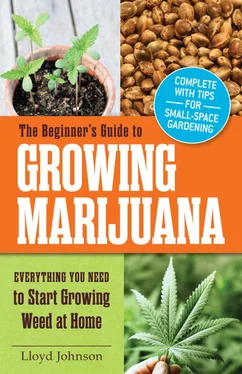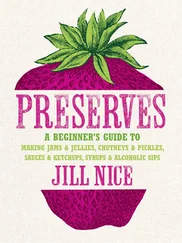Many outdoor growers start their plants indoors and have them already well grown and ready for hardening off and outdoor transplant when spring arrives. The outdoor grower wants as much time for vegetative growth as possible; once the sunlight drops to twelve hours, your plants will slow and then stop increasing in size, and begin to concentrate on producing flowers. Unlike the indoor grower, you have no control over this timing. The female cannabis plant’s hard-wired ultimate goal is to reproduce through pollination, so it will focus every bit of its energy on this very important activity. The grower benefits by frustrating the plant’s desire by withholding access to male pollen.
Transplanting on Schedule
Any seedling going in the ground should be strong and tall enough to do so safely. Until they are at least two to three feet in height, they need containers to protect them. This is also about the size at which cannabis normally shows its sexual identity. Until they sex, you should not plant undifferentiated seedlings in the ground or their final large container. It becomes too hard to move the males, and it takes a lot of work and expensive materials to prepare a final plant site.
The outdoor grower should plan on needing three-gallon and five-gallon containers for each of the seedlings’ interim phase. The rooted cuttings, or clones, should also be allowed to reach two to three feet for ground planting. If you are growing them full cycle in a large container, go ahead and plant or “bump” them right away; you know they are females and you can encourage vigorous vegetative growth right away. The clones will not have to experience more than one transplant shock; seedlings go through one or two. This can be so minimal that the plants probably are not even aware that they have been replanted.
Preparing to Transplant
When you get ready to transplant, always have everything ready to go. The goal is to minimize any shock or damage to the plants; otherwise, they lose valuable time recovering and adjusting themselves, meaning loss of size and productivity. You will need:
• The container, washed and clean, or the ground site prepared and lined with chicken wire for each plant to be transplanted
• Prepared soil, screened and amended with compost and minerals
• Bone meal
• Water
• Sharpie pen for writing on containers, or premade labels for each plant
• Young plant to be transplanted
Plan to transplant in the cool of the evening; this gives the plants a cool, dark period to adjust to their new homes. If you must transplant during the day, try to get it done in the early morning before the sun gets high and hot.
Water the waiting soil and stir to make certain it is uniformly dampened, and check that the water is draining from the container well. Make a hole a few inches deeper and wider than the transplant’s current container, and scratch in a handful of bone meal. This will be easily accessible to the plant’s roots and will aid in strong root production.
Transplant Assistants
One person can easily perform early transplants. Once the plants grow to three feet or more, or are in heavy five-gallon containers, it is much easier and also safer for the plants to have a transplanting assistant. Remember, to get the plant out of the pot, you are going to be turning it over and using gravity to slide the root ball out. If you are not particularly tall, a tall helper is essential. Root balls also do not always slide right out, and wrestling a heavy, earth-filled container while trying not to break the plant can get tricky.
Keep It Simple
If you are using a helper, always make certain that you both understand the plan—who is pulling the pot, and who is supporting and turning the plant. A misunderstanding can cause confusion that can lead to broken plants or root balls. This is always easier to work out before you are holding an extremely heavy container and are in midpull.
As soon as the pot-puller frees the root ball, he can quickly set the pot down and help support the root ball until it is settled gently into its new container or the ground site. It is usually a good idea to bring the plants awaiting transplant to their ground site or the larger containers one at a time. Pot-pullers can get excited and fling an empty container as they jump forward to help support the root ball; unfortunately, if they fling blindly, a waiting plant can get broken.
Finalizing the Transplant
Once the transplant is settled gently in place, fill in with more of your prepared soil and gently press around the plant’s main stem with the palms of your hands flat. This will help bring the roots in contact with the soil. Water gently and press again to settle the plant. Make certain the plant’s identifying label or tag is secured or written on the side of the container with indelible pen. Now you are finished and can start on the next one.
Sexing Male and Female Plants
As we discussed in Chapter 3, cannabis from seed starts out with no visible sexual differentiation at all. The main concern is to provide them with light, water, and plenty of food for strong roots and healthy vegetative growth until they sex, or declare. At this point, all your seedlings can stay together, although you need to think through which genetic traits are the most important to you, how many males you want, and where to put them once they declare. They will have to be moved quickly once they provide proof of their sexual determination.
The male and female cannabis plants have very different-looking flowers that develop from a tiny nub, known as the primordia , located initially on the main stems. The best place to check for flowering is at the top of the plant at the nodes (or intersections) where the plant develops a small leaf spur. The initial primordia will appear behind this spur and will start out looking like a tiny rounded pod.
Eventually the primordia either elongates into a tubular-looking female calyx or the more rounded nubbin of the developing male flower. The easiest way to sex cannabis plants is to wait for two white hairs, or pistils , that will appear from the end of the female calyx. These pistils can also appear pinkish or yellowish, but they are very clear declarations that the plant is female.
Keep It Simple
A novice grower can avoid some anxiety by asking an experienced grower to show him the first pistils, but if this resource is not available to you, do not worry. You know what you are waiting for, and when you see it for the first time it will be clear.
Remember that the plants will spend a fair amount of time over this process; it is not necessary to identify sexual determination and act within hours. You can keep watching for days until there is a clear and unambiguous display of the pistils.
Once your plants have declared, you must remove the males to their isolated, enclosed space to wait for pollen production. Make certain the males will be indoors where they can be severely segregated; absolutely no random pollen transfer should be possible.
As soon as you have collected pollen, you can breed selected branches on the females you choose to breed. There is no reason to wait until the female makes big flowers; pollination and fertilization can take place as soon as the pistils are displayed. Breeding early on also allows time for seed to mature; breeding later in the season can result in pale, whitish-green, immature seeds that are not likely to be viable.
Fertilizing for Vegetative Growth
Different organic soil amendments are usually needed when you are starting a grow site. Testing your soil and understanding the different properties of different organic amendments can, along with your budget, help you choose wisely. Packaged amendments generally list nitrogen, phosphorus, and potassium in that order. Always check, as extremely high nitrogen can burn plants.
Читать дальше












